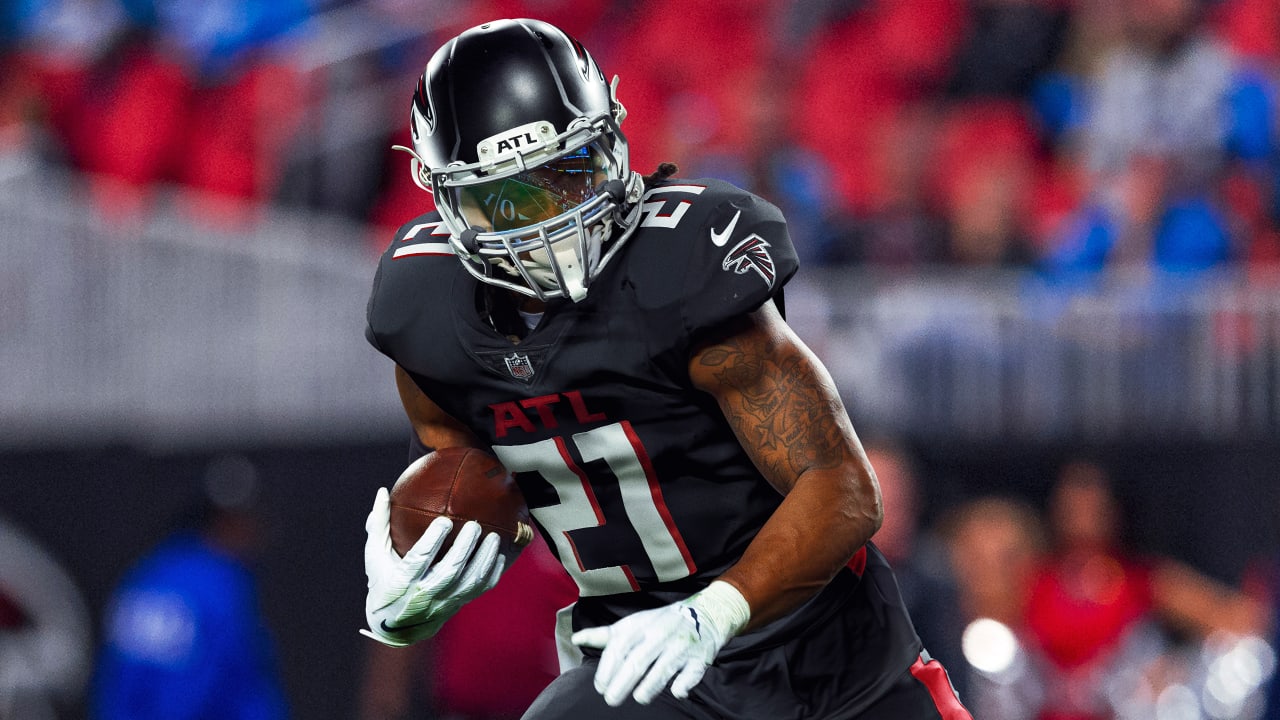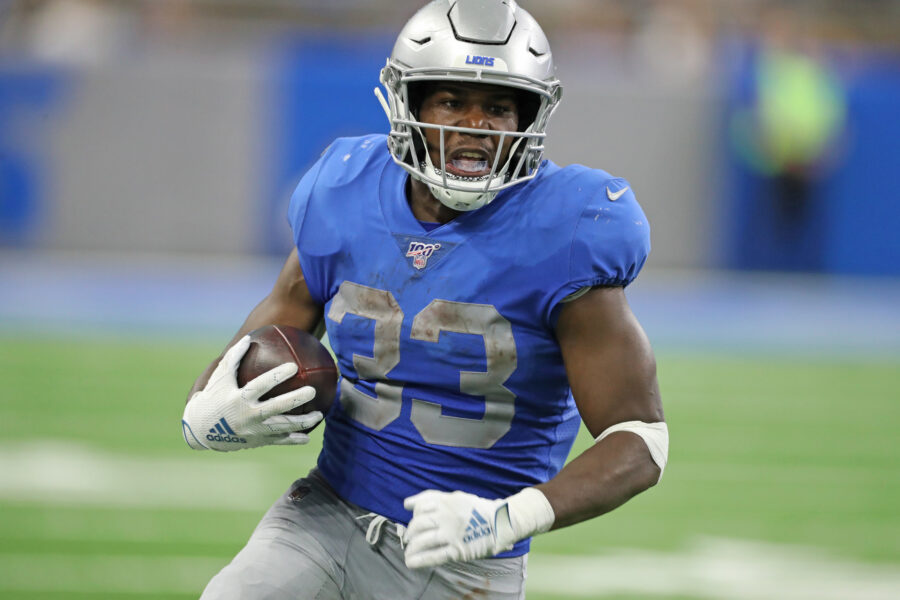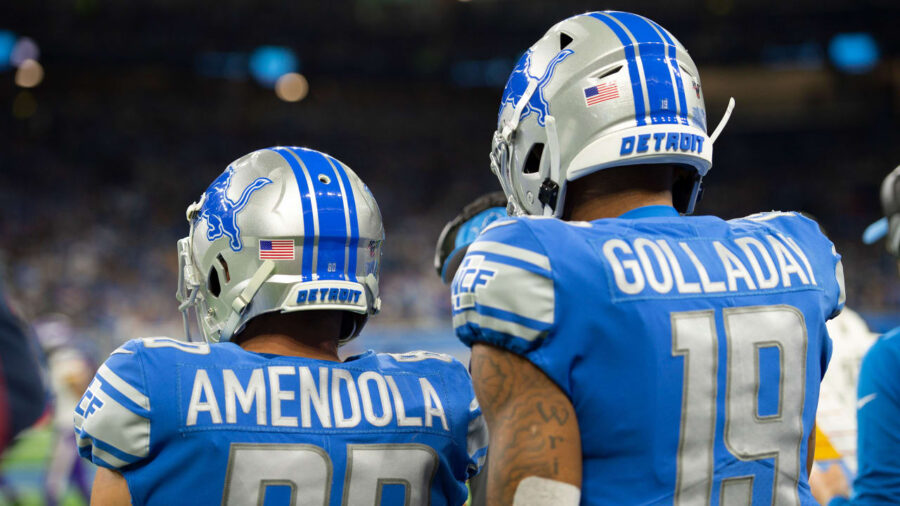NFL Game Scripts Week 7: Detroit Lions @ Atlanta Falcons
Atlanta showed that once again, in the first game after firing a Head Coach, teams find a way to win, knocking off the Vikings in Week 6. Similarly, Detroit were another Week 6 winner, perhaps showing that Head Coach Matt Patricia deserves to stay. After Week 5 both teams would have been forgiven for feeling as though the postseason was out of reach, but another win now could catapult a strong run in the second half of the season.
Atlanta Falcons Offense vs. Detroit Lions Defense
The Run Game

With RB Todd Gurley leading the way on the ground, Atlanta use backups Brian Hill and Ito Smith to keep Gurley fresh for the whole game. Gurley is sent outside the Tackles as much as possible, but will also regularly run up the middle as well. Hill will be sent on zone runs towards the Tackles, staying inside or cutting outside depending on the LB’s movement, while Smith mostly attacks between the Tackles. The TEs will provide extra blockers, especially for Gurley, with a TE moved to the slot, before coming back in to block and spring Gurley to the outside with a clearer rushing lane. Hill and Smith provide similar roles to Gurley, although a little less in the passing game.
Barring a large collapse where the Falcons are playing from a long way behind, for most of the game Gurley (interspersed with Hill and Smith) will be used on inside and outside zone runs. While they will want to run outside often, the Falcons will remain patient early on so that the Lions don’t stack the edges for containment. Instead, with a balance of inside runs, it will allow the Falcons to increasingly use their TEs to disguise their runs. With a few runs behind the TE in the first half, the Falcons will begin moving the TE from either side of the OL, and use a mixture of strong and weak run plays so that the Lions have to remain neutral on defense. While continuing to run blast, dive and counters through the middle, in the second half Atlanta will also use toss plays to get Gurley to the outside, with a TE or OT/OG providing a lead blocker against the DL and LBs.
Detroit will primarily try to keep their DL handling the OL, leaving them to move their LBs around to exploit different matchups. A combination of LBs in Jarrad Davis, Jamie Collins, Christian Jones and Jahlani Tavai will be slid around the defense, starting from lining up behind the DL. From there, the OLBs will wrap around the outside of the OT and track the RBs when they are used on outside runs, while also starting from a position to defend inside runs. The Safeties will be brought up to the line of scrimmage to provide an extra defender that negates the TE, keeping the LB free to attack the RB. Although the Lions risk exposing themselves to big plays if the OLBs miss tackles or can’t slow Gurley down for the second and third defenders, if it succeeds it will restrict Gurley from too many runs of more than 5 yards.
The Passing Game

With WR Julio Jones healthy again, Atlanta can happily return to their 3WR sets with their starters. With Jones on one sideline, it allows Calvin Ridley to patrol the other and play out of the slot on one side, as well as Russell Gage as an inside receiver on intermediate routes. Gurley will see some work as a receiver out of the backfield, but the Falcons will want to test the Lions’ secondary by using additional 4WR formations. TE Hayden Hurst will be on the field for most plays, although will almost exclusively run shorter out and hitch routes.
Jones will regularly for the entire game be used on vertical outside routes, with some slants and deep in routes used later in the game. This allows Ridley to either play the opposite sideline, spreading the DBs and Safeties out, leaving space for Gage over the middle. Alternatively, Ridley will also be moved to the slot inside of Jones, and can run a stacked slants as the underneath receiver, or an in or out route underneath the Safety and CB that are tracking Jones. The Falcons will continue to use these different route combinations for most of the game, but if they struggle will increase their WR bunch formations, with Jones becoming the short receiver on a crossing route to get the ball into his hands. Hurst will continue to provide the shorter passing option to the outside for most of the game, although will run a few deeper routes as the WRs run mesh routes underneath. A few WR and TE screens will be integrated in the second half as well, but the Falcons will continue to try and push the ball downfield with Jones and Ridley, creating space for Gage and Hurst underneath temporarily, before Jones and Ridley are then given greater variation.
Detroit will mostly have rookie CB Jeff Okudah on the left side of their defense, where he likely faces off against Jones most often, which Atlanta will feel good about their chances in that matchup. Although the Lions will keep a Safety, usually Duron Harmon, over the top to help Okudah, depending on how Atlanta move their WRs will also force the Lions to move Harmon to where there are 2 WRs. CB Desmond Trufant will play opposite Okudah as well, giving the Lions at least one matchup where they will feel their CB could potentially have some success against Ridley, until he starts seeing more work over the middle. If Harmon isn’t in deeper coverage, he will sometimes be used in man coverage against Gage, with fellow Safety Tracy Walker mostly defending Hurst. Detroit’s LBs will play zones across the middle of the field as well to further reduce the space for Hurst and Gage, although they will need to at times drop further back than usual if Jones and Ridley run deeper slants and in routes. The LBs will also be used to blitz in different ways, moving them around to bring pressure from the inside and outside at different times.
What Should We Expect To See On Sunday?
Atlanta will regularly attack downfield in the first half, but will be forced to use their top two WRs on shorter routes over the middle for a while as Detroit adjusts. With inside and outside runs throughout the game, Detroit will deploy their LBs to cover the space over the middle and in the flats against the RBs. The Falcons will move their WRs around with different route combinations to force the Safeties to show their coverage, allowing one of the WRs to cut in or stay deep in single coverage. Unless the Lions’ CBs can have greater success against the WRs in one-on-one matchups all game though, Atlanta will aim to exploit their advantage of having two dynamic receivers that can create separation in different ways.
Detroit Lions Offense vs. Atlanta Falcons Defense
The Run Game

With rookie RB D’Andre Swift starting to show the burst the Lions drafted him for, they can start to be more creative with their run game. While Adrian Peterson will continue to be given handoffs up the middle, Swift will be used on runs inside and outside the Tackles, as well as serving as a receiver regularly. Kerryon Johnson will be given a few snaps as a runner and occasional receiver, but is the RB3 at this point.
Peterson and Swift will alternate drives and successive snaps for most of the game, even if one appears to be having greater success. Peterson’s physicality will be used to to wear down the DL, before Swift uses his agility on zone rushing plays to hit the holes that are created by the OL. Swift will see additional outside runs than Peterson does, as the Lions try to get him into space. As the game enters the second quarter and second half, the Lions will use play action with both RBs, as well as stretch plays to give Peterson and Swift fewer defenders to run at, as they head to the outside. The Lions should try to remain balanced with consistent run designs from the first to fourth quarter, unless they are significantly behind on the scoreboard.
Atlanta’s run defense has been mediocre this season, mostly relying on their LBs to close any holes left by their DL. Their DEs will move inside and outside of the OTs, tempting the Lions to run at the hole created, where their LB will be waiting. The Falcons will “spy” Swift especially and not rush their LBs, instead keeping them waiting to see where Swift heads and trying to get him before he can get into space. Safety Keanu Neal will be used in this role as well, sitting amongst the LBs so that he can get to either side of the line depending on Swift’s direction. By not being too aggressive against the run, the Falcons can instead fill the second level and avoid big plays by leaving holes behind the line of scrimmage.
The Passing Game

Detroit use a mixture of 2 and 3 WR sets, alternating between them frequently to create different mismatches. With Kenny Golladay healthy once more, the Lions have their deep threat again, while Marvin Jones provides the intermediate route runner. Their other WRs, Danny Amendola and Quintez Cephus, are used as additional receivers over the middle or on the outside, respectively. The RBs are mostly used on slants, curls and swings to the outside, although Swift and Johnson can be used as extra receivers from the line as well. TE TJ Hockenson sees a mixture of deep vertical routes, as well as curls and in routes over the middle, while backup TE Jesse James mostly sees work on short and intermediate out routes.
With these different arrangements, the Lions can mix and match levels concepts with flat-7s and some bootlegs for Stafford to throw on the run. Golladay will continually be sent deeper, running a mixture of go and corner routes, as well as slants and in routes, trying to get behind the defense or allow Stafford to lead him on passes so that the CB can’t jump it. Jones and Hockenson will be used inside Golladay at different times, usually with one running an underneath slant, or vertical/scissors route to split the DBs. The remaining receiver, either a WR or TE, will be the most variation throughout the game, as the Lions will continue to run these route combinations for most of the game, occasionally using Golladay on shorter routes to avoid the Safety in double coverage. Cephus will provide a second outside receiver on vertical and comeback routes, while Amendola and James will run crossing and mesh routes with Jones or Hockenson. A few TE screens and RB screens will be integrated during the second quarter, but for the majority of the game the Lions won’t vary their play calling when passing. Success running the ball will allow extra bootlegs with the receivers stacked over each other for simpler progressions, and will be used during the second and third quarters. The fourth quarter will see Detroit either continue to send Golladay deep if the game remains close, otherwise they will shift to spacing concepts instead and increased screens to run the clock out if they can establish a lead.
The Falcons lack the depth in their secondary to win one-on-one matchups with both Hockenson and Golladay simultaneously. With rookie CB AJ Terrell struggling to keep up with his opposing WR, the Falcons will instead try to have Isaiah Oliver shadow Golladay throughout the game. Safety Ricardo Allen will spend most of the game deep, with Keanu Neal mostly trying to guard Hockenson. Atlanta could look to try zone coverage at times to take away the middle of the field for Jones, Hockenson and Amendola, especially with Cover 6 and Cover 5. While this could tempt Detroit to send extra receivers on vertical routes, it creates more risk and more chances for Atlanta to force incompletions, even if it could result in big gains.
What Should We Expect To See On Sunday?
Detroit will remain balanced as longs they can, and if the run is having success, could increase their rushing plays in the third quarter. With Golladay as a constant deep threat, the Lions will continue to stretch the defense and take underneath throws if it continues to net yardage, and then deep shots again. The Lions will rotate through different formations to prevent the Falcons falling into a rhythm, throwing to all areas of the field throughout the game based on what the defense gives them, as well as using the run game to set up play action and RB screens for short yardage plays. Atlanta will focus on taking away the RBs as threats with their LBs, while exploring some zone defenses to reduce the passing lanes for Stafford. Yet with their secondary, the Lions should be able to create space on the outside throughout the game.

